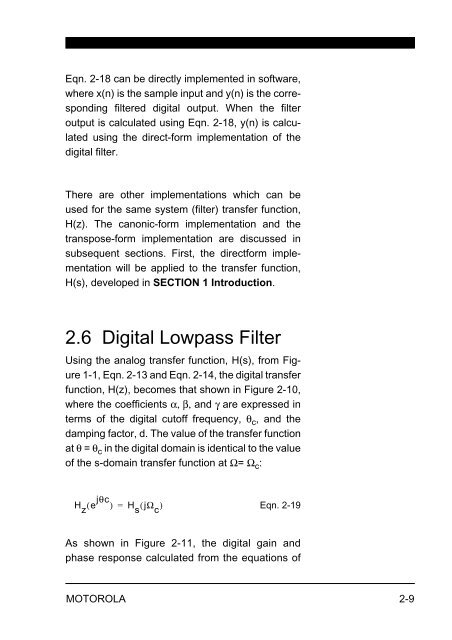Implementing IIR/FIR Filters
Implementing IIR/FIR Filters
Implementing IIR/FIR Filters
Create successful ePaper yourself
Turn your PDF publications into a flip-book with our unique Google optimized e-Paper software.
Eqn. 2-18 can be directly implemented in software,<br />
where x(n) is the sample input and y(n) is the corresponding<br />
filtered digital output. When the filter<br />
output is calculated using Eqn. 2-18, y(n) is calculated<br />
using the direct-form implementation of the<br />
digital filter.<br />
There are other implementations which can be<br />
used for the same system (filter) transfer function,<br />
H(z). The canonic-form implementation and the<br />
transpose-form implementation are discussed in<br />
subsequent sections. First, the directform implementation<br />
will be applied to the transfer function,<br />
H(s), developed in SECTION 1 Introduction.<br />
2.6 Digital Lowpass Filter<br />
Using the analog transfer function, H(s), from Figure<br />
1-1, Eqn. 2-13 and Eqn. 2-14, the digital transfer<br />
function, H(z), becomes that shown in Figure 2-10,<br />
where the coefficients α, β, and γ are expressed in<br />
terms of the digital cutoff frequency, θ c , and the<br />
damping factor, d. The value of the transfer function<br />
at θ = θ c in the digital domain is identical to the value<br />
of the s-domain transfer function at Ω= Ω c :<br />
H<br />
z<br />
e jθc<br />
( ) =<br />
H<br />
s<br />
( jΩ<br />
c<br />
)<br />
Eqn. 2-19<br />
As shown in Figure 2-11, the digital gain and<br />
phase response calculated from the equations of<br />
MOTOROLA 2-9
















